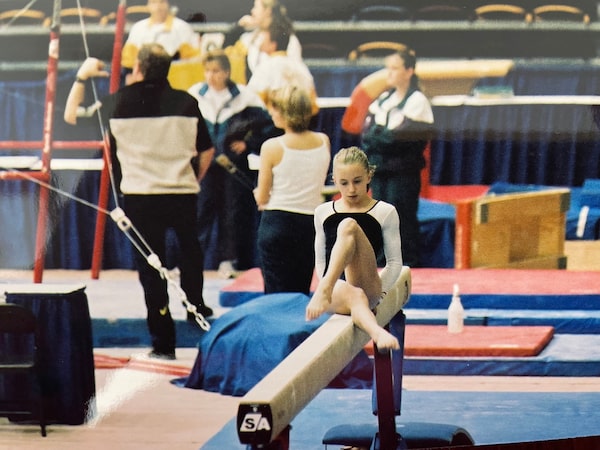
A group of gynmasts filed a claim on May 11, 2022, against Gymnastics Canada and the federation's provincial counterparts for having tolerated a climate of abuse and mistreatment for decades. The lawsuit was filed at the Supreme Court of British Columbia in the westernmost Canadian province where lead plaintiff and former gymnast Amelia Cline resides.AFP/Getty Images
Kim Shore is a former gymnast, the mother of a former gymnast, and a former board member of Gymnastics Canada.
“You’re too fat to be a gymnast! Look at your stomach! You’re an embarrassment, useless, a waste of my time. Are you stupid? Stop faking that injury. Did you just roll your eyes at me?”
How many times a week could you endure these words? What if the person saying them was twice your size and in a position of power – and was, in some cases, literally holding your physical safety in their hands? Maybe, in a fit of frustration, they’ve already dropped you on your head from six feet in the air, or told you to keep training after you hit your head so hard you blacked out, or overstretched you until your hamstring snapped and then punished you for the injury with gruelling conditioning. What if this was the price you had to pay as a child to flip and fly and do the sport you loved?
These are the kinds of shocking allegations that have emerged over the decades about Gymnastics Canada, signalling a culture of cruelty that threatens gymnasts, of whom more than 80 per cent are children. Too often, however, the “solution” has been to simply revise safe-sport policies or repeat the now-meaningless mantra of “zero tolerance.” And while the federal government recently created the Office of the Sport Integrity Commissioner to handle abuse complaints from athletes on national teams, it is focused on individual complaints rather than patterns of behaviour, and there remains no way to address past harms.
So there’s still no effective mechanism to ensure that abusive individuals across the sport, from the grassroots on up, are kept away from athletes. This means victims will still have to rely on last resorts for accountability: going public or taking civil action. Can we really ask this of a 10-year-old?
Putting an end to endemic child abuse in sport requires organizations to transform their cultures and embrace their supra-parental responsibilities, with a special focus on the rights of children and their protection.
Too many gymnasts say they had nowhere to turn when the abuse was happening. Police seem ill-equipped to handle abuse in sport, even if the criminal-case threshold is met. And the fear of negative repercussions, including being publicly humiliated by coaches and losing friendships, have a chilling effect on reporting. Victims worry they won’t be believed, or that they’ll be seen as weak, a trouble maker, or unfit to pursue their sport. Even parents may stay quiet out of fear of humiliation, bullying, retribution (ie, being labelled as the “crazy parent”), or further harm directed at their child. Allegations that high-profile and influential coaches instilled abusive cultures suggest these concerns are not without merit.
Sadly, many athletes go on to blame themselves for how they are treated, and sometimes turn to self-harming behaviours to cope. Those who do stay in the system risk becoming desensitized, and potentially passing on the toxic training environments of their own youth to a new generation of athletes.
Hypothetically, Gymnastics Canada’s code of conduct and its suite of safe sport policies are enforceable through both administrative and disciplinary action. But there is a broad perception among athletes that sport administrators either condone misconduct or are willing to turn a blind eye, and that the existing complaint process lacks transparency and consistency while favouring the alleged abuser’s privacy and position. Indeed, the moral courage required to take a hard stance against bullying, harassment and abuse is not the norm.
Change can only occur with the active engagement of senior sport leaders who will acknowledge the problem, clearly state that such misconduct is unacceptable, sanction perpetrators and adopt a comprehensive strategy targeting normalized maltreatment.
Gymnastics is supposed to be a safe, exciting and developmentally appropriate space for children to explore their athletic potential and learn lessons about resilience, hard work and teamwork. No one expects that the journey will always be easy; no one expects everyone to get a ribbon. But no one should be expected to endure humiliation, preventable lifelong injuries and degrading, inappropriate behaviour by the very adults they have been taught to trust.
More than 500 people have signed an open letter calling for an independent investigation into gymnastics in Canada. And so it’s time for the federal Sport Minister, Sport Canada, Gymnastics Canada and provincial sport leaders to actually tackle the issue of abuse in gymnastics. A better future is not possible without exposing past harms and dysfunctional systems, and ensuring accountability or rehabilitation for perpetrators. Sexual, physical and psychological abuse not only harms victims, but also the integrity, professionalism and viability of the sport.
Nine other countries have already investigated their gymnastics programs, with the results justifying drastic change to policy or legislation. So what is Canada waiting for?
Keep your Opinions sharp and informed. Get the Opinion newsletter. Sign up today.